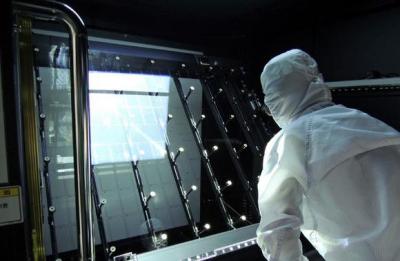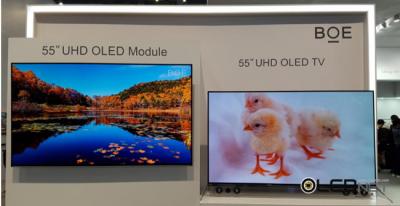OLED ink jet printing: introduction and market status - Page 13
UBI Research sees PECVD as the in-organic TFE equipment of choice for flexible OLED production
UBI Research says that as OLED makers are diverting all efforts into flexible OLED production, thin film encapsulation (TFE) is gaining in popularity. Between 2017 and 2021, TFE will be applied to about 70% of all OLED panels in production. The OLED encapsulation equipment market will generate $11 billion in sales.

TFE encapsulation started out as a complex technology that required 11 layers and was slow and expensive. Recent advances allowed OLED makers to reduce the number of layers to just 3 and increase productivity and yields and so lower the production costs. Some film OLED makers opted for hybrid encapsulation (which uses a barrier film) but TFE seems to have become the technology of choice.
Guangzhou New Vision demonstrates its latest flexible and foldable OLEDs
China's Guangzhou New Vision demonstrated its latest flexible and foldable AMOLED displays at SID DisplayWeek. According to the company in the video below, these displays will enter production in 1.5 years.
As can be seen in the video, the company is developing flexible OLEDs with a resolution of 400 PPI on oxide-TFT backplanes and Polyimide substrates. New Vision also develops printing technologies (for both OLED and QLED displays, interestingly) - but these are still in an early stage, it seems.
UDC accelerates its OVJP R&D, shows how the process works
Universal Display recently announced that it is accelerating OVJP R&D, and the company is looking to commercialize this technology with partners. UDC expects it to take a few years before OVJP can really be deployed in production. The company published the video below that shows off the technology and explains the basic principles and advantages.
OVJP stands for Organic Vapor Jet Printing, and the basic idea is to use a gas-stream based process that resembles ink-jet printing but one that uses evaporation OLED materials which outperform soluble ones. In an OVJP process, the OLED materials are evaporated into a carrier gas that delivers them to a jet engine for direct printing of patterned OLED layers. OVJP is intended for large-area OLED displays and can be scaled up to 10-Gen substrates according to UDC.
Sumitomo Chemical starts to promote PLED materials and printers for OLED display production
Sumitomo Chemical acquired CDT back in 2007, and since then the Japanese company has been developing it's PLED (polymer-based OLED) materials and technologies. While initially Sumitomo aimed to produce materials for displays, in recent years it has focused mostly on OLED lighting materials and even panel production.

A noted exception was Panasonic's OLED TV development project which used printing technologies and Sumitomo's PLED materials. But Panasonic terminated this project in 2013. We speculated that JOLED, which is based on Panasonic's technology (and other technologies as well), uses PLED materials in its prototypes, but we were not sure.
LG aims to adopt a blue TADF emitter in its 2018 OLED TV stack
Korean news site DDaily posted an interesting article that states that LG Display is looking to replace the fluorescent OLED emitter used in its OLED TVs with a blue TADF emitter.

Following the introduction into LG's OLED TV production process, LG hopes to also use TADF materials in its small and medium OLED production. The report is a bit confusing, but it seems that LGD also aims to use its WOLED display in small and medium display formats - even for VR applications.
Sony may be JOLED's first customer for its 21.6" 4K medical OLED monitors
Last month JOLED announced that it started to sample 21.6" 4K OLED monitors. JOLED plans to develop these OLED monitors for medical applications - it will produce these in low volume at its current 4.5-Gen pilot production line, and will start mass production in 2019.

JOLED's CEO, Nobuhiro Higashiiriki, said in a conference that these first samples were shipped to Sony, which may become JOLED's first customer. JOLED says that the company managed to achieve a high quality and long lifetime, which was a challenge due to the printing process used.
BOE to use Kateeva's inkjet printed to establish a pilot OLED TV production line in Hefei
In February 2017 BOE Display announced that will establish a new R&D OLED TV production line in Hefei. According to Digitimes, BOE Display is intending to use an inkjet printing process in this line, and the company already placed an order for an inkjet deposition system from Kateeva last month. BOE will use the systems to produce 55" OLED TVs.

In February BOE announced that the new line will cost 1 billion CNY (around $145 million USD). BOE will invest 80% of the funds, with the rest provided by the Hefei government. Digitimes now states that the new line will only cost 600 million CNY - so it may be that the inkjet printing line is an addition to the 1 billion CNY line (which in that case, will probably be based on an evaporation process).
BOE demonstrates Q-LED display prototypes
Last week BOE demonstrated two Q-LED displays, 5" (320x240) and 14" (960x540). These prototype displays use electroluminesence quantum-dots as emitting materials.

According to BOE, switching to an in-organic emitter enables a display that features an excellent display quality - on part with OLED displays - while also being compatible with ink-jet printing, which will enable QLED displays to be lower-cost compared to OLEDs.
IHS: OLED TV shipments to reach 10 million 2023, but growth will decelerate
IHS says that OLED TV shipments will reach 10 million units in 2023, up from about 1.5 million in 2017. The OLED TV market will grow at a CAGR of 42% from 2017, but the growth will decelerate as can be seen in the chart below.

The high costs of producing OLED TV panels will remain a challenge and will be the main reason why production of OLED TV panels won't accelerate in the near future. Producers are looking into ink-jet printing as a way to lower production costs but the soluble emitting materials are still under performing and also the production yields are still low. IHS says that OLED makers are aiming to start mass printing OLED TV panels by 2019.
JOLED starts to sample 21.6" 4K printed OLED monitors
JOLED announced that it started to sample 21.6" 4K OLED monitors. These monitors, demonstrated in March 2017, feature a 3840x2160 resolution (204 PPI), a brightness of 350 cd/m2 and a contrast ratio of 1,000,000 : 1. The panel thickness is 1.3 mm and the weigh is 500 grams.

JOLED aims to start mass producing these panels in 2019, but will also attempt to sell these to the medical market even in low-volume production out of its current 4.5-Gen pilot production line.
Pagination
- Previous page
- Page 13
- Next page

